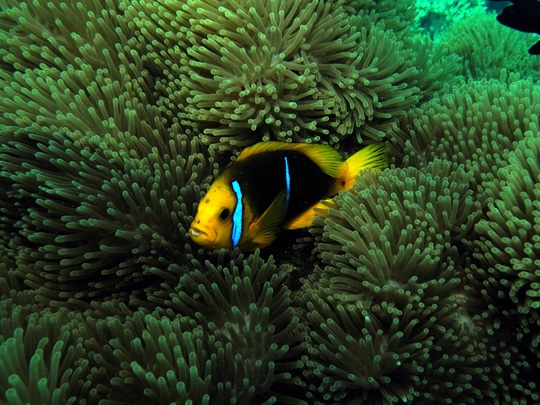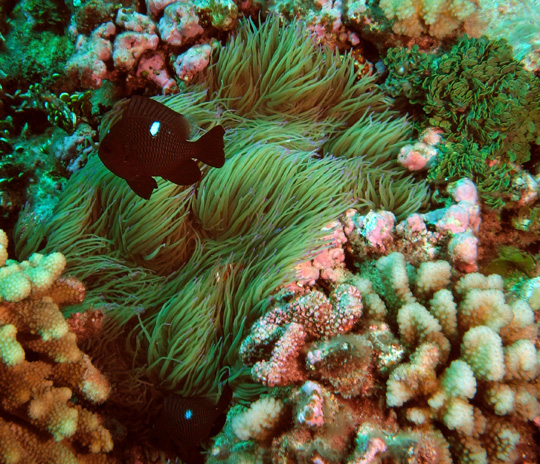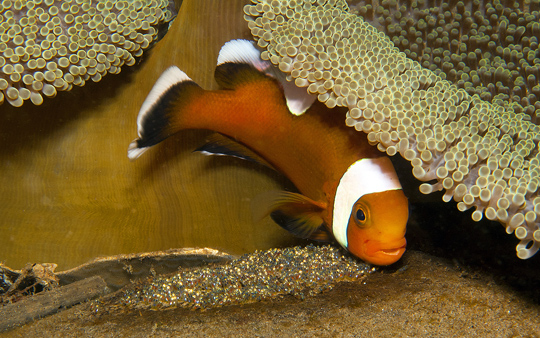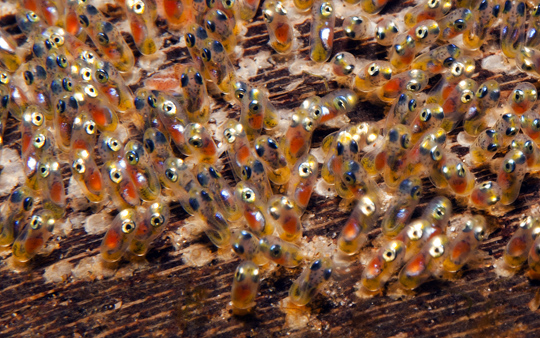Clownfishes and anemonefishes are among the most iconic creatures residing in coral reefs. In Scilly and Bellinghausen, the science team sighted several colorful orange-finned anemonefishes (Amphirion chrysopterus) residing in anemones scattered throughout the shallows of the reef sites.

Clownfishes belong to larger group of fishes generally known as anemonefishes, due to their symbiotic relationship with these cnidarians. In nature, these fishes are never found without an anemone, they have an obligate association with their host. Within the tentacles of the anemones, they find protection from predators. The anemone’s tentacles have specialized stinging cells (cnidoblasts) that deliver a toxin that most fishes rather avoid.

Even though anemonefishes appear to swim “unpunished” around their hosts’ tentacles, they are actually stung by the anemone. In fact, they undergo an acclimation process that allows them to withstand the stinging tentacles of the anemone. This process resembles an elaborate swimming dance in which the fish starts by gingerly touching the tentacles with its ventral fins only, progressing to their belly and then the remaining body, until it is finally able to dive right in. Click here to watch a short video of anemonefishes interacting with their host anemones.
Besides offering protection from predators, the host is also crucial for anemonefishes’ reproduction, as they lay their eggs beneath the oral disc overhang of the anemone. After hatching and going through the larval stages, young fishes settle to the sea bottom and begin their search for a suitable host anemone.

Like many other fish species, anemonefishes go through a sex change. Unlike most fishes, they display a male to female sex reversal. There is usually a dominant large female and one or more males in each anemone, or cluster of anemones. When this female dies, the ovaries of one of the males become active and he replaces the dominant female, while one of the non-breeding individuals becomes the functioning male.
Females lay between 100 and 1,000 eggs in their nests, which are then fertilized and attended by the male. The males guard and care for the eggs throughout the whole incubation period, aggressively chasing away other fishes, frequently fanning the eggs and removing debris and dead eggs with their mouth.

There are 28 species of anemonefishes that can associate with one or more of 10 anemone species. Some fish species associate with a single anemone species, while others can associate with a number of different species. True anemonefishes belong to two genus: Amphiprion and Premnas. Identification of these fishes in the wild can be tricky, as color patterns are highly variable. So far we’ve only seen a few species of clown fishes. As the Society Islands research expedition continues, the science team hopes to encounter more of these iconic fishes.
(Photos by: 1-2 Dr. Andy Bruckner, 3-4 Ken Marks)
To follow along and see more photos, please visit us on Facebook! You can also follow the expedition on our Global Reef Expedition page, where there is more information about our research and team members.
